nursing elite online revision materials
I know how frustrating it can get with all those assignments mate.
Nursing Being my main profession line, i have essential guides that are A graded, I am a very friendly person so dont worry inquiring more from me
- 391
- 0
- 0
Community
- Followers
- Following
3 Reviews received
391 items
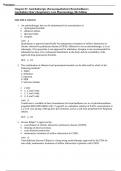
Gardenhire-2015-9th-0323299687-Sample
Gardenhire-2015-9th-7-SampleChapter 07: Anticholinergic (Parasympatholytic) Bronchodilators Gardenhire: Rau’s Respiratory Care Pharmacology, 9th Edition MULTIPLE CHOICE 1. An anticholinergic that can be administered via aerosolization is a. ipratropium bromide. b. albuterol sulfate. c. glycopyrrolate. d. atropine. ANS: A Ipratropium is approved specifically for maintenance treatment of airflow obstruction in chronic obstructive pulmonary disease (COPD). Albuterol is not an anticholin...
- Exam (elaborations)
- • 10 pages •
Gardenhire-2015-9th-7-SampleChapter 07: Anticholinergic (Parasympatholytic) Bronchodilators Gardenhire: Rau’s Respiratory Care Pharmacology, 9th Edition MULTIPLE CHOICE 1. An anticholinergic that can be administered via aerosolization is a. ipratropium bromide. b. albuterol sulfate. c. glycopyrrolate. d. atropine. ANS: A Ipratropium is approved specifically for maintenance treatment of airflow obstruction in chronic obstructive pulmonary disease (COPD). Albuterol is not an anticholin...
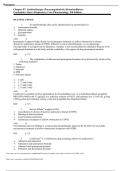
Pharm7.pdf
PMULTIPLE CHOICE 1. An anticholinergic that can be administered via aerosolization is a. ipratropium bromide. b. albuterol sulfate. c. glycopyrrolate. d. atropine. ANS: A Ipratropium is approved specifically for maintenance treatment of airflow obstruction in chronic obstructive pulmonary disease (COPD). Albuterol is not an anticholinergic; it is an adrenergic. Glycopyrrolate is not approved for inhalation. Atropine is not recommended for inhalation because of its widespread distributi...
- Exam (elaborations)
- • 9 pages •
PMULTIPLE CHOICE 1. An anticholinergic that can be administered via aerosolization is a. ipratropium bromide. b. albuterol sulfate. c. glycopyrrolate. d. atropine. ANS: A Ipratropium is approved specifically for maintenance treatment of airflow obstruction in chronic obstructive pulmonary disease (COPD). Albuterol is not an anticholinergic; it is an adrenergic. Glycopyrrolate is not approved for inhalation. Atropine is not recommended for inhalation because of its widespread distributi...
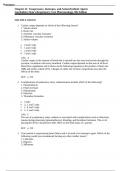
Chapter 21: Vasopressors, Inotropes, and Antiarrhythmic AgentsGardenhire: Rau's Respiratory Care Pharmacology, 9th Edition
c21 Chapter 21: Vasopressors, Inotropes, and Antiarrhythmic Agents Gardenhire: Rau’s Respiratory Care Pharmacology, 9th Edition MULTIPLE CHOICE 1. Cardiac output depends on which of the following factors? 1. Venous return 2. Heart rate 3. Systemic vascular resistance 4. Pulmonary vascular resistance 5. Stroke volume a. 2 and 5 only b. 1 and 3 only c. 2 and 4 only d. 3 and 5 only ANS: A Cardiac output is the amount of blood that is ejected into the aorta and travels through the ...
- Exam (elaborations)
- • 12 pages •
c21 Chapter 21: Vasopressors, Inotropes, and Antiarrhythmic Agents Gardenhire: Rau’s Respiratory Care Pharmacology, 9th Edition MULTIPLE CHOICE 1. Cardiac output depends on which of the following factors? 1. Venous return 2. Heart rate 3. Systemic vascular resistance 4. Pulmonary vascular resistance 5. Stroke volume a. 2 and 5 only b. 1 and 3 only c. 2 and 4 only d. 3 and 5 only ANS: A Cardiac output is the amount of blood that is ejected into the aorta and travels through the ...
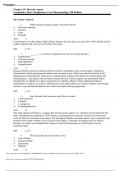
Pharm19.pdf
PChapter 19: Diuretic Agents Gardenhire: Rau’s Respiratory Care Pharmacology, 9th Edition MULTIPLE CHOICE 1. Which group of diuretic agents is the most potent? a. Potassium-sparing b. Osmotic c. Loop d. Thiazide ANS: C Loop diuretics are often called “high-ceiling” diuretics because they can cause 20% of the filtered load of sodium chloride and water to be excreted in the urine. REF: p. 322 2. ________ is a common complication in the use of loop diuretics. a. Hypokalemia b. V...
- Exam (elaborations)
- • 7 pages •
PChapter 19: Diuretic Agents Gardenhire: Rau’s Respiratory Care Pharmacology, 9th Edition MULTIPLE CHOICE 1. Which group of diuretic agents is the most potent? a. Potassium-sparing b. Osmotic c. Loop d. Thiazide ANS: C Loop diuretics are often called “high-ceiling” diuretics because they can cause 20% of the filtered load of sodium chloride and water to be excreted in the urine. REF: p. 322 2. ________ is a common complication in the use of loop diuretics. a. Hypokalemia b. V...
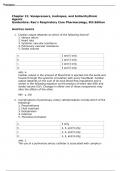
c21.rtf
Chapter 21: Vasopressors, Inotropes, and Antiarrhythmic Agents Gardenhire: Rau’s Respiratory Care Pharmacology, 9th Edition MULTIPLE CHOICE 1. Cardiac output depends on which of the following factors? 1. Venous return 2. Heart rate 3. Systemic vascular resistance 4. Pulmonary vascular resistance 5. Stroke volume a. 2 and 5 only b. 1 and 3 only c. 2 and 4 only d. 3 and 5 only ANS: A Cardiac output is the amount of blood that is ejected into the aorta and travels through the syst...
- Exam (elaborations)
- • 16 pages •
Chapter 21: Vasopressors, Inotropes, and Antiarrhythmic Agents Gardenhire: Rau’s Respiratory Care Pharmacology, 9th Edition MULTIPLE CHOICE 1. Cardiac output depends on which of the following factors? 1. Venous return 2. Heart rate 3. Systemic vascular resistance 4. Pulmonary vascular resistance 5. Stroke volume a. 2 and 5 only b. 1 and 3 only c. 2 and 4 only d. 3 and 5 only ANS: A Cardiac output is the amount of blood that is ejected into the aorta and travels through the syst...
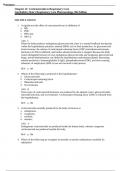
c11.rtf
Chapter 11: Corticosteroids in Respiratory Care Gardenhire: Rau’s Respiratory Care Pharmacology, 9th Edition MULTIPLE CHOICE 1. A significant side effect of corticosteroid use is inhibition of a. IgE. b. PDE. c. HPA axis. d. SRS-A. ANS: C When the body produces endogenous glucocorticoids, there is a normal feedback mechanism within the hypothalamic-pituitary–adrenal (HPA) axis to limit production. As glucocorticoid levels increase, the release of corticotropin-releasing factor (CR...
- Exam (elaborations)
- • 18 pages •
Chapter 11: Corticosteroids in Respiratory Care Gardenhire: Rau’s Respiratory Care Pharmacology, 9th Edition MULTIPLE CHOICE 1. A significant side effect of corticosteroid use is inhibition of a. IgE. b. PDE. c. HPA axis. d. SRS-A. ANS: C When the body produces endogenous glucocorticoids, there is a normal feedback mechanism within the hypothalamic-pituitary–adrenal (HPA) axis to limit production. As glucocorticoid levels increase, the release of corticotropin-releasing factor (CR...
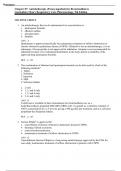
Ch 7 - Anticholinergic Bronchodilators.pdf
Ch 7 - Anticholinergic B Chapter 07: Anticholinergic (Parasympatholytic) Bronchodilators Gardenhire: Rau’s Respiratory Care Pharmacology, 9th Edition MULTIPLE CHOICE 1. An anticholinergic that can be administered via aerosolization is a. ipratropium bromide. b. albuterol sulfate. c. glycopyrrolate. d. atropine. ANS: A Ipratropium is approved specifically for maintenance treatment of airflow obstruction in chronic obstructive pulmonary disease (COPD). Albuterol is not an anticholiner...
- Exam (elaborations)
- • 11 pages •
Ch 7 - Anticholinergic B Chapter 07: Anticholinergic (Parasympatholytic) Bronchodilators Gardenhire: Rau’s Respiratory Care Pharmacology, 9th Edition MULTIPLE CHOICE 1. An anticholinergic that can be administered via aerosolization is a. ipratropium bromide. b. albuterol sulfate. c. glycopyrrolate. d. atropine. ANS: A Ipratropium is approved specifically for maintenance treatment of airflow obstruction in chronic obstructive pulmonary disease (COPD). Albuterol is not an anticholiner...
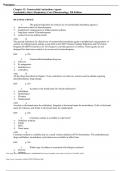
Pharm12.pdf
PChapter 12: Nonsteroidal Antiasthma Agents Gardenhire: Rau’s Respiratory Care Pharmacology, 9th Edition MULTIPLE CHOICE 1. The general indication for clinical use of nonsteroidal antiasthma agents is a. short-term control of bronchospasm. b. prophylactic management of mild persistent asthma. c. long-term control of bronchospasm. d. control of severe asthma attack. ANS: B The general indication for clinical use of nonsteroidal antiasthma agents is prophylactic management, or control,...
- Exam (elaborations)
- • 7 pages •
PChapter 12: Nonsteroidal Antiasthma Agents Gardenhire: Rau’s Respiratory Care Pharmacology, 9th Edition MULTIPLE CHOICE 1. The general indication for clinical use of nonsteroidal antiasthma agents is a. short-term control of bronchospasm. b. prophylactic management of mild persistent asthma. c. long-term control of bronchospasm. d. control of severe asthma attack. ANS: B The general indication for clinical use of nonsteroidal antiasthma agents is prophylactic management, or control,...

c9 (1).rtf
c9 (1).rtfChapter 09: Mucus-Controlling Drug Therapy Gardenhire: Rau’s Respiratory Care Pharmacology, 9th Edition MULTIPLE CHOICE 1. Which of the following are functions of mucus in the body? 1. Lubrication 2. Improvement of gas exchange 3. Waterproofing 4. Protection from inflammation a. 1 and 3 only b. 1 and 4 only c. 1, 3, and 4 only d. 1, 2, 3, and 4 ANS: C Mucus lubricates the airways, acts to “waterproof” the airways by forming a gel layer that floats over a water peric...
- Exam (elaborations)
- • 15 pages •
c9 (1).rtfChapter 09: Mucus-Controlling Drug Therapy Gardenhire: Rau’s Respiratory Care Pharmacology, 9th Edition MULTIPLE CHOICE 1. Which of the following are functions of mucus in the body? 1. Lubrication 2. Improvement of gas exchange 3. Waterproofing 4. Protection from inflammation a. 1 and 3 only b. 1 and 4 only c. 1, 3, and 4 only d. 1, 2, 3, and 4 ANS: C Mucus lubricates the airways, acts to “waterproof” the airways by forming a gel layer that floats over a water peric...

Pharm9.pdf
PChapter 09: Mucus-Controlling Drug Therapy Gardenhire: Rau’s Respiratory Care Pharmacology, 9th Edition MULTIPLE CHOICE 1. Which of the following are functions of mucus in the body? 1. Lubrication 2. Improvement of gas exchange 3. Waterproofing 4. Protection from inflammation a. 1 and 3 only b. 1 and 4 only c. 1, 3, and 4 only d. 1, 2, 3, and 4 ANS: C Mucus lubricates the airways, acts to “waterproof” the airways by forming a gel layer that floats over a water periciliary la...
- Exam (elaborations)
- • 13 pages •
PChapter 09: Mucus-Controlling Drug Therapy Gardenhire: Rau’s Respiratory Care Pharmacology, 9th Edition MULTIPLE CHOICE 1. Which of the following are functions of mucus in the body? 1. Lubrication 2. Improvement of gas exchange 3. Waterproofing 4. Protection from inflammation a. 1 and 3 only b. 1 and 4 only c. 1, 3, and 4 only d. 1, 2, 3, and 4 ANS: C Mucus lubricates the airways, acts to “waterproof” the airways by forming a gel layer that floats over a water periciliary la...

Test bank Medical-Surgical Nursing Concepts for Interprofessional Collaborative Care 10th Edition All Chapters (1-69) |A+ ULTIMATE GUIDE 2021
Test bank Medical-Surgical Nursing Concepts for Interprofessional Collaborative Care 10th Edition All Chapters (1-69) |A+ ULTIMATE GUIDE 2021
2022 2023 latest test nclex rn nr326 hesi a2 v2 ati ob